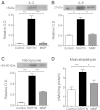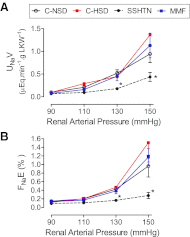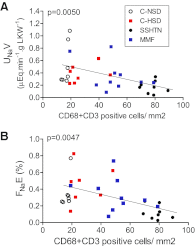Impaired pressure natriuresis resulting in salt-sensitive hypertension is caused by tubulointerstitial immune cell infiltration in the kidney
- PMID: 23364804
- PMCID: PMC3625854
- DOI: 10.1152/ajprenal.00463.2012
Impaired pressure natriuresis resulting in salt-sensitive hypertension is caused by tubulointerstitial immune cell infiltration in the kidney
Abstract
Immune cell infiltration of the kidney is a constant feature in salt-sensitive hypertension (SSHTN). We evaluated the relationship between the renal inflammation and pressure natriuresis in the model of SSHTN that results from transient oral administration of N(ω)-nitro-L-arginine methyl ester (L-NAME). Pressure natriuresis was determined in Wistar rats that received 4 wk of a high-salt (4% NaCl) diet, starting 1 wk after stopping L-NAME, which was administered alone (SSHTN group, n = 17) or in association with mycophenolate mofetil (MMF; MMF group, n = 15). The administration of MMF in association with L-NAME is known to prevent the subsequent development of SSHTN. Control groups received a high (n = 12)- and normal (0.4%)-salt diet (n = 20). Rats with SSHTN had increased expression of inflammatory cytokines and oxidative stress. The severity of hypertension correlated directly (P < 0.0001) with the number of tubulointerstitial immune cells and angiotensin II-expressing cells. Pressure natriuresis was studied at renal arterial pressures (RAPs) of 90, 110, 130, and 150 mmHg. Glomerular filtration rate was similar and stable in all groups, and renal blood flow was decreased in the SSHTN group. Significantly decreased natriuresis (P < 0.05) was found in the SSHTN group at RAPs of 130 and 150 mmHg, and there was an inverse correlation (P < 0.01) between the urinary sodium excretion and the number of tubulointerstitial inflammatory cells (lymphocytes and macrophages) and cells expressing angiotensin II. We conclude that tubulointerstitial inflammation plays a key role in the impairment of pressure natriuresis that results in salt-dependent hypertension in this experimental model.
Figures







References
Publication types
MeSH terms
Substances
Grants and funding
LinkOut - more resources
Full Text Sources
Other Literature Sources
Medical

